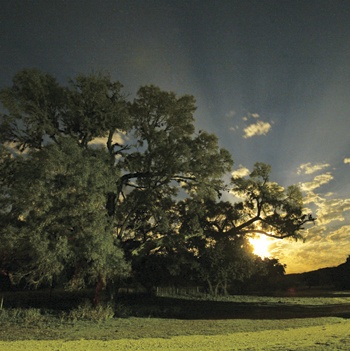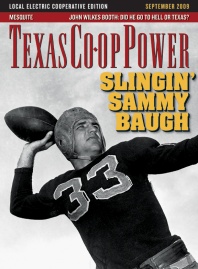Mesquite has achieved iconic status in Texas, but it doesn’t get much respect. Rather than terms such as “majestic” and “grand,” the tree is called “tough,” “persistent” … and worse.
Nothing with thorns that can scratch people and critters is ever going to be universally loved, but mesquite was not quite as reviled in days of yore as it has become in recent years.
Early-day ranchers like W.T. Waggoner called mesquite “the devil with roots,” but others from that era were fond of the stuff. J. Frank Dobie wrote, “No day can be counted entirely lost which begins with the smell of mesquite fire at dawn and the taste of coffee boiled over it.”
Ken E. Rogers wrote the book on mesquite: The Magnificent Mesquite (2000, University of Texas Press) details the many uses and abuses of mesquite through the years. He notes that honey mesquite (by far the most common species in Texas) not only provided early Western travelers with both food and shelter but also inspired, even then, mixed emotions in the eyes of its beholders. He wrote that they “looked at it as a noble warrior, confronted it as a powerful adversary, or were drawn to it for survival.”
Native American tribes made their peace with mesquite by using it the same way they used buffalo, which is to say they used all of it. They used the bean pods to make food and medicine and the bark to make baskets, rope, tools, weapons, cradles and other everyday items. Even mesquite gum had dozens of uses, from coloring pottery to treating head lice and stomach problems. Modern research indicates the gum also helps the tree absorb and retain water; in the human body, the same compounds slow the release of sugars into the blood.
Diabetes epidemics among Native American populations were almost unheard of until the middle of the 20th century when desert tribes in particular suffered spiraling rates of diabetes and obesity. Some researchers believe that the health epidemics began when modern-day Native Americans started getting their food from the supermarket instead of the desert, where, for generations, sweet and juicy mesquite beans were a staple of desert tribes of the Southwest.
Early European settlers may not have recognized the nutritional value of mesquite beans, but they used the wood—which is so hard it is sometimes called Texas ironwood—as fuel for fireplaces, stoves and steam locomotives. It was used for fence posts and even as paving blocks for downtown streets in San Antonio and Brownsville.
That mesquite can be such a hard, sturdy and downright pretty material might surprise people who think of mesquite as more of a bush than a tree. Left to its own devices, a mesquite tree can grow to be at least 50 feet tall and recognized as a tree among trees. A new mesquite shoot that is disturbed will develop as a multitrunked shrub instead of a single-trunked tree and can, in time, become a mesquite forest.
What we don’t see is what goes on underground, which is where the mesquite does the dirty work that has led to charges of its being an incorrigible sod snatcher and water thief. The mesquite has lateral roots that extend 30 feet or more from the tree with a taproot that usually extends about 10 feet into the ground but can extend much farther where there is a deep water table. Dense stands along waterways, above shallow water tables or in deep soils absorb the water that other plants and shrubs need to survive. When those plants and shrubs die, more mesquite moves in to fill the void.
A case can be made against mesquite in the epic proliferation that it now enjoys, but our civilization has to stand trial as a co-conspirator because everything we’ve done since we got here has worked in the mesquite’s favor. The suppression of prairie fires and the eradication of prairie dogs, along with stresses from cattle drives and heavy grazing, plus natural elements such as droughts, have combined to make the Southwest very mesquite-friendly. Texas is now home to some 56 million acres where mesquite plays a dominant role in the ecosystem; those acres make up about three-quarters of all such ecosystems in the country.
Lest we adopt an attitude that all mesquite is bad for the environment, it’s important to remember that a little bit of mesquite is not necessarily a bad thing. Mesquite is a legume, same as clover and other well-known nitrogen fixers, and increases the soil’s store of nitrogen.
A combination of prescribed burns and mechanical, chemical and biological controls are used against mesquite. All the while, the seeds are still under the soil, still germinating, still waiting to reproduce and thrive once more.
In addition to everything else for which tribes of the Southwest used mesquite, they also knew that food cooked over a mesquite fire is something special. The rest of the country caught on to that fact in the 1980s, when mesquite became the wood of choice for chefs and backyard grilling gurus all over the country. The sudden national popularity of mesquite for outdoor cooking and smoking created a new industry for people wanting to use and profit from all that mesquite. Tons of mesquite, mostly in Texas, are harvested, processed, packaged and sold all over the world as mesquite chips and mesquite chunks. The words “mesquite grilled” appear on menus all across the country, from the back-road barbecue joint to the five-star downtown restaurant.
Mesquite blossoms also provide good nectar for honey, and mesquite honey is widely available in supermarkets. Specialty stores and other outlets sell mesquite jelly and mesquite flour. A tea can be made from the beans.
Woodworkers like mesquite because it is a quality hardwood in a league with oak, walnut and cherry as both a pleasure and a challenge with which to work. Rogers, in The Magnificent Mesquite, writes, “With its swirling grain, variable color, and occasional character defects—such as ingrown bark, mineral streaks, bug blemishes, and latent buds—mesquite offers a hidden treasure for the woodworker.”
It’s used to craft a wide number of items, from golf clubs to musical instruments to jewelry. It has proven especially suitable as a flooring material, as seen at San Antonio’s Hilton Palacio del Rio hotel, where the mezzanine and lobby floors are made of mesquite.
In the best of all possible worlds, we would find ways to use not only all of a single mesquite, much as the Native Americans did, but also ways to use and manage all the mesquite that is available. The Texas Mesquite Association (www.texasmesquiteassn.org), with headquarters in Fredericksburg, holds two annual festivals highlighting mesquite furniture and art made by its selected members. This year’s fall festival is scheduled for October 9-11 in downtown Fredericksburg. Since 2004, the association has also held a spring festival in San Angelo and estimates that the two festivals combined attract about 30,000 people each year. A spring seminar brings together mesquite enthusiasts for clinics, discussions, presentations and safety information.
Mesquite is also being studied as a potential source of biofuel at the Texas AgriLife Research and Extension center near Vernon. Bob Avant, bioenergy program director for Texas AgriLife Research in College Station, says that 70 to 90 gallons of biofuel can be produced from one dry ton of mesquite, depending on the conversion technology. If harvesting, marketing and conversion technologies can be created, the “devil with roots” might be a fuel of the future.
If that happens, we can only hope that the new fuel emissions smell like mesquite.
——————–
Clay Coppedge, a frequent contributor to Texas Co-op Power, is a staff writer and columnist for Country World newspaper.


